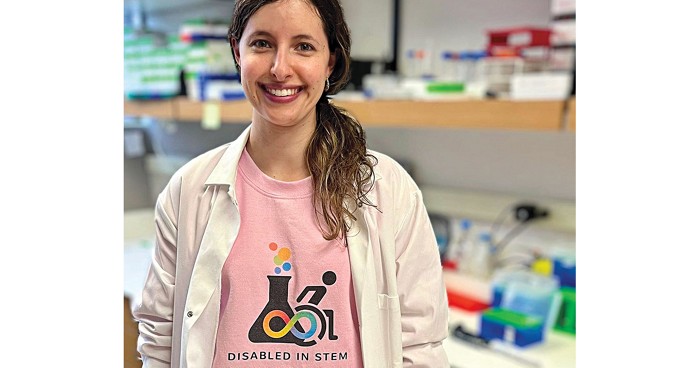Advertisement
Grab your lab coat. Let's get started
Welcome!
Welcome!
Create an account below to get 6 C&EN articles per month, receive newsletters and more - all free.
It seems this is your first time logging in online. Please enter the following information to continue.
As an ACS member you automatically get access to this site. All we need is few more details to create your reading experience.
Not you? Sign in with a different account.
Not you? Sign in with a different account.
ERROR 1
ERROR 1
ERROR 2
ERROR 2
ERROR 2
ERROR 2
ERROR 2
Password and Confirm password must match.
If you have an ACS member number, please enter it here so we can link this account to your membership. (optional)
ERROR 2
ACS values your privacy. By submitting your information, you are gaining access to C&EN and subscribing to our weekly newsletter. We use the information you provide to make your reading experience better, and we will never sell your data to third party members.
Diversity
Get to know the ACS Inclusivity Style Guide
This guide can help when you want to ensure your message is welcoming to everyone in your audience
by Rajendrani Mukhopadhyay, ACS staff
September 18, 2023
| A version of this story appeared in
Volume 101, Issue 31

In November 2017, I was taken aback when I saw a C&EN headline that read, “Proteomics goes native.” As a science writer and editor with a PhD in biochemistry, I knew the article would be about an important advance in proteomics research. But as someone with roots in India, I understood the phrase “goes native” was derogatory to people of color who lived under colonialism. The headline caused hurt when the intention was lighthearted wordplay.
When I became the leader of the Office of Diversity, Equity, Inclusion, and Respect (DEIR) in spring 2021, the first thing I wanted the office to do was tap into the power of words. If the American Chemical Society was going to succeed with its strategic goal to embrace and advance inclusion in chemistry, we needed to start with language.
Enter the idea of creating an ACS Inclusivity Style Guide. I was inspired by the C&EN Style Guide, an internal document that I relied heavily on for inclusive language during my tenure at the magazine. Using the C&EN Style Guide as the framework, ACS launched the ACS Inclusivity Style Guide by the end of 2021. The free online resource was, and continues to be, created by a cross-functional team of writers, editors, web designers, and DEIR experts from across ACS.
The guide can be consulted to ensure you use welcoming language and images for everyone in your audience—whether you’re creating emails, memos, articles, surveys, or other types of materials. We have received feedback saying that the ACS Inclusivity Style Guide poses as the language police, but it is literally what it says it is: a guide.
The guide is regularly updated to respond in a timely fashion to evolutions in language. It focuses on US English, and I hope it inspires speakers of different languages to create similar resources. The whole ACS Inclusivity Style Guide can be found at www.acs.org/inclusivityguide.
Tip sheets, which accompany the guide, are being highlighted in C&EN in this special series. These tip sheets pull advice from evergreen portions of the guide. An introduction and two tip sheets will be available in this issue and the next five issues of C&EN. If you can’t wait that long for the full collection, you can find all the tip sheets in the “Related resources” section in the online guide.
The tip sheets in this installment focus on general language guidelines as well as inclusive narratives, frames, and sentence structures. You’ll learn how to avoid reducing people to one characteristic and find examples, including of active phrasing.
If you have feedback about the guide, please email ISG@acs.org. If you have suggestions for other types of resources that will help create an inclusive and welcoming environment for you and others around you, please email the Office of DEIR at diversity@acs.org.
MORE ONLINE
Like what you’ve read? See the full guide and the most up-to-date tip sheets from the American Chemical Society at www.acs.org/inclusivityguide.
General guidelines
For more context, review the “General guidelines” section of the Inclusivity Style Guide.
Language evolves
Visit the full guide periodically to ensure your language stays up to date. Periodic reviews for outdated language are especially important for those maintaining web pages.
Involve a diverse group of people
Be as inclusive and collaborative as you can while creating content, particularly when writing for a broad audience. Do not rely on the same person every time a topic relating to a group they belong to arises.
Respect self-descriptions
Ask people how they want to be described, and respect that language. This includes the use of pronouns, the mention of racial or ethnic background, the use of honorifics or titles, and even the career role and spelling of someone’s name.
Mention personal information thoughtfully
Mentioning a characteristic such as race for some people and not others can introduce bias. Mention personal information only when it is immediately relevant to the topic.
Avoid labels
Avoid labeling people by a characteristic, and recognize that a particular characteristic does not define or describe a person as a whole.
Example
✓ Use: older people
⦻ Avoid: the elderly
Be appropriately specific
Avoid relying on a label for a large group of people when discussing only a subset of that group.
Example
✓ Use: Black, Hispanic, and Asian students reacted positively.
⦻ Avoid: Students of color reacted positively.
Narratives, framing, and sentence structure
For more context, review the “Narratives, framing, and sentence structure” section of the Inclusivity Style Guide. Use this tip sheet in combination with the “General guidelines” tip sheet.
Think about your frames and narratives
The way people or issues are described can promote or disrupt stereotypes. Some elements of frames and narratives include the following:
- Sources: Aim to include a variety of voices in your content, and center the people most affected. Be transparent about conflicts of interest and sources that undermine social justice and equity.
- Order: Be aware of how the information mentioned first sets the tone of your communication and primes people to think a certain way.
- Explanations: Give context behind differences among groups, such as health outcomes for people of different races and ethnicities. And avoid overexplaining identities that are not part of dominant cultures.
- Comparisons: Carefully consider which groups you’re comparing and which is implied to be the standard. Avoid equating things that are qualitatively different, such as violence against people and damage to businesses during protests. Also recognize how your choice of metaphor, such as “flood” to describe immigration, may perpetuate stereotypes.
Frames and narratives to avoid
- Deficit framing: Deficit framing leads with people’s struggles. Instead, lead with their assets.
- Blaming: Avoid language that seems to blame marginalized people for inequitable outcomes. Instead, name the true causes, such as racism, heterosexism, and other forms of discrimination and oppression.
- Overcoming and exceptions: Overfocusing on individual success stories may imply that personal effort is the answer to systemic injustices. Instead, put stories in context and support personal cases with group successes.
- Polarization: Pitting groups in opposition to one another can feed into an “us versus them” mentality.
- White saviorism: Framing White people as saviors of people of color denies people of color’s agency and power.
Use active phrasing
Choose a sentence structure that names oppressors. Avoid wording that is more passive and abstract and that omits agents.
Example
✓ Use: The university discriminated against her.
⦻ Avoid: She was discriminated against.
⦻ Avoid: Discrimination occurred at the university.
⦻ Avoid: There was discrimination at the university.
Think about who is missing
Recognize when an explicit or implied “we” refers to only a subset of people. Also notice when lists of identity groups might fail to acknowledge overlapping identities.
Example
✓ Use: In 2020, White people in the US finally began to reckon with racism in the US.
⦻ Avoid: In 2020, we finally began to reckon with racism in the US.
ACS Inclusivity Style Guide Tip Sheets
- Part 1: “General guidelines” and “Narratives, framing, and sentence structure”
- Part 2: “Forms” and “Race, ethnicity, and nationality”
- Part 3: “Images” and “Data visualization”
- Part 4: “Accessibility” and “Disabilities, disorders, and other health conditions”
- Part 5: “Socioeconomic status” and “Age”
- Part 6: “Gender and sexuality” and “Body size”








Join the conversation
Contact the reporter
Submit a Letter to the Editor for publication
Engage with us on Twitter